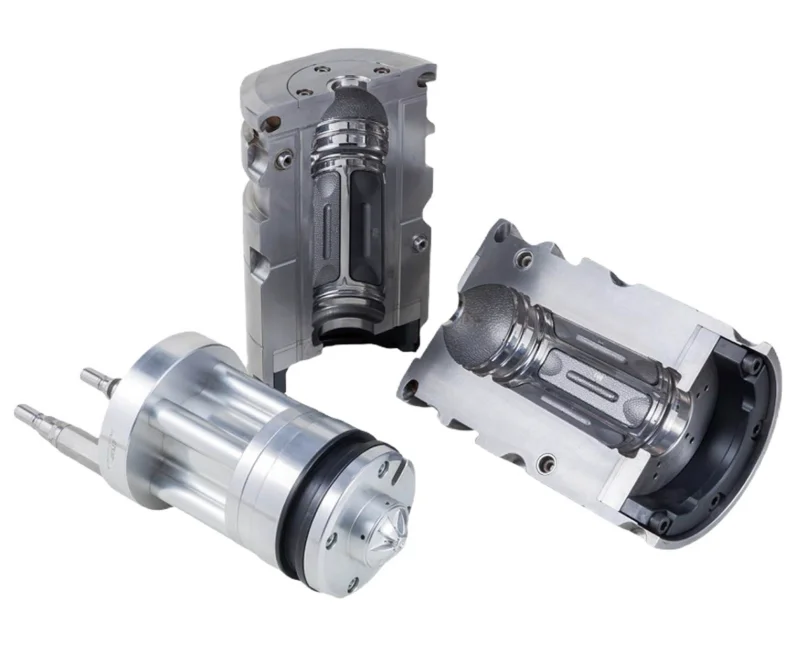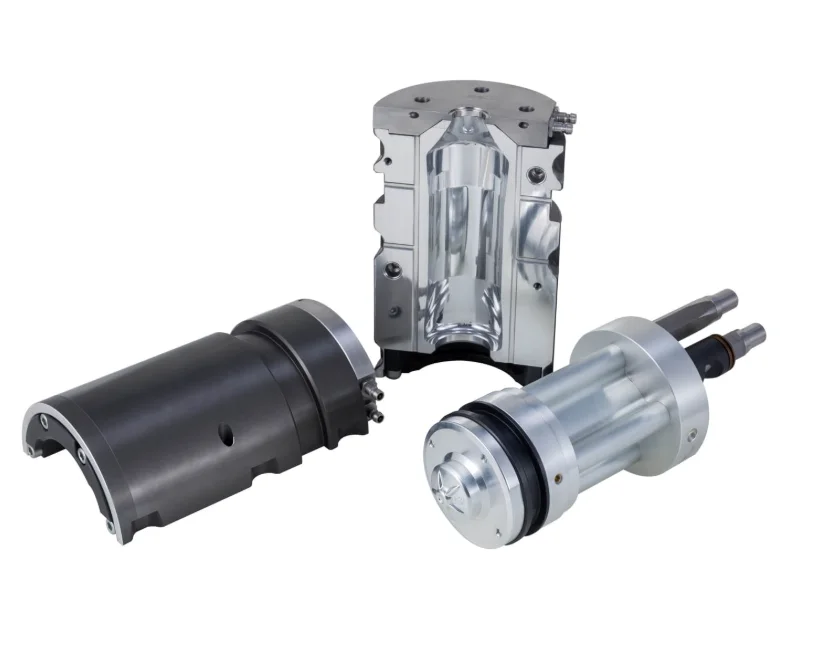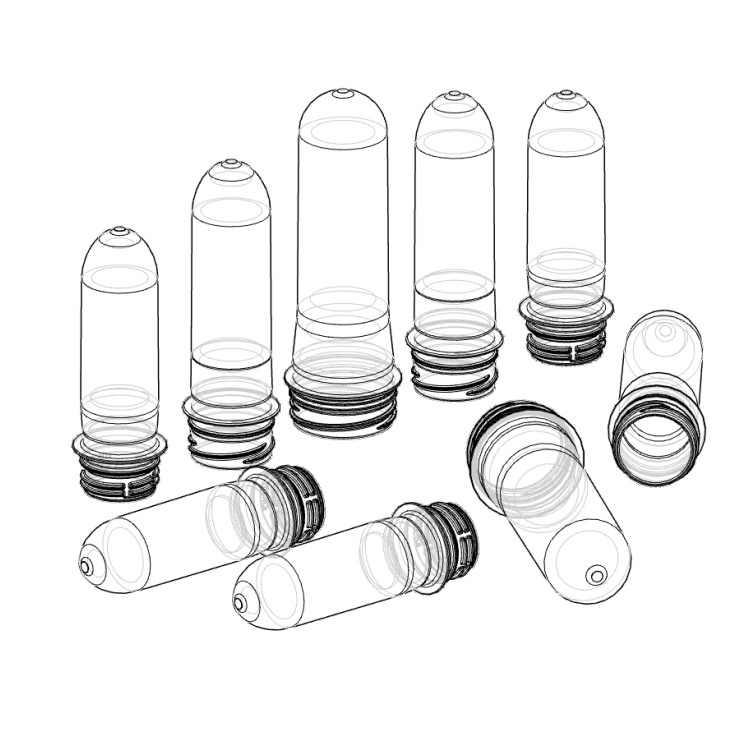How Pet Blowing Mold Impacts Wall Thickness and Clarity in PET Containers
Carefully crafted PET blow molds deliver exceptional bottle transparency, even wall thickness, and leak-proof performance—crucial for fast-paced manufacturing in industries like drinks, medicine, and beauty products.

Overview of PET Blow Molding Technology
Blow molding is a vital method in the packaging world, especially for creating PET jars and bottles. This process turns PET preforms into ready-to-use containers through steps involving heat, stretching, and air pressure.
Key Stages in the PET Blow Molding Process
The journey of PET blow molding starts by warming up a pre-shaped PET preform. Once it hits the right warmth, it’s placed into a mold without delay. High-pressure, food-safe air is then pumped in. This air makes the preform swell to match the mold’s shape. This method guarantees the container fits the mold perfectly, right down to the neck threads and label spots.
The mold is at the heart of this process. It’s an essential piece in making plastic bottles, using blow molding to shape heated plastic preforms into specific designs. It has to withstand intense heat and force while keeping its exact measurements.
Importance of Mold Design in Final Container Quality
The way a mold is built has a direct effect on the product’s reliability, clear look, and wall thickness. Important details like the shape of the cavity, cooling paths, and surface smoothness decide how well containers hold up under pressure or heat changes.
For example, a good mold allows for a variety of bottle designs. This helps customers stand out and gain an edge over competitors. A smartly designed mold also ensures a tight seal, which is super important for fizzy drinks and hot-fill uses.
Influence of Pet Blowing Mold on Wall Thickness Distribution
Having consistent wall thickness is key for strength and saving material. If it’s uneven, you might end up with weak areas or waste extra plastic.
Factors Affecting Wall Thickness During Stretch-Blow Molding
In the stretch-blow molding step, the preform is stretched lengthwise and then expanded outward. Several things affect wall thickness at this stage. These include the preform’s shape, how fast it’s stretched, the air pressure used, and, most critically, the mold’s outline.
This specially designed PET preform mold cavity is made for super light preform production. Its solid, one-piece build gets rid of gaps seen in older, split designs. This boosts precision in molding and makes the structure stronger. Such innovation leads to steady thickness, even in tricky shapes.
Role of Mold Temperature and Material Flow
Keeping the mold’s temperature in check affects how evenly the melted PET spreads and hardens against the cavity walls. If the heat isn’t balanced, cooling can be uneven. This might cause bending or uneven crystal formation in the plastic.
Stable molding comes from a well-thought-out runner design. It ensures uniform wall thickness and a tight seal. Good heat control also keeps the flow even as the preform expands.
BJY’s Precision Mold Engineering for Consistent Wall Thickness
If you’re looking for fast production with very few defects, BJY’s PET blowing molds are built using top-notch CNC tools for super tight accuracy. Each piece is crafted from aircraft-quality aluminum and tough S136 steel inserts. This means better precision, less waste, and reliable bottles batch after batch.
Their one-piece cavity designs cut down on bending under stress. They also keep sealing areas consistent, which is vital for light bottles used for water or personal care items.

Impact of Pet Blowing Mold on Optical Clarity of PET Containers
A clear appearance isn’t just for looks—it shapes how consumers see a product and ensures quality in fields like beauty or medicine.
Surface Finish and Its Effect on Light Transmission
If the mold cavity has a rough surface, that texture shows up on the final bottle. A smooth, polished finish cuts down on light scattering through the walls. This results in a sharper, more see-through look.
The mold is often used to make 2-liter PET bottles for water, juices, and health drinks that need to look top-notch. That clear quality begins with the mold’s surface.
Controlling Crystallinity Through Mold Cooling Systems
The clearness of PET depends a lot on staying non-crystalline after cooling. If cooling is slow or uneven due to poor channel setup or uneven heat in the mold, crystals form more. This lowers transparency.
High-tech cooling setups in precise molds help manage crystal levels well, even in thicker parts like the base or neck of a bottle.
How BJY Molds Optimize Clarity in High-Transparency Applications
With BJY’s rotary blowing molds, you get cooling paths designed for quick, even hardening. They offer high output, great quality, low upkeep, and safe operation. This makes them perfect for crystal-clear packaging, like premium water bottles, keeping a stunning look even in large runs.
Design Considerations in Pet Blowing Mold for Enhanced Performance
Small design details affect not just how well a mold works but also how fast it runs and how it fits with automated systems downstream.
Gate Location, Venting, and Parting Line Precision
Where the gate is placed controls how material flows during injection. If it’s in the wrong spot, it can cause messy flow or visible lines. Likewise, venting needs to be enough to let trapped air out without leaving burn spots or gaps.
The modular build makes cleaning, upkeep, and part swaps easier. This setup also keeps the parting line aligned over time, which is key for making flash-free containers even after countless cycles.
Preform-Mold Compatibility and Stretch Ratios
The preform you pick must suit the mold’s shape and the stretch levels you want. Stretching too much can thin the walls too far. Not stretching enough misses out on strength or clearness benefits.
These molds work with recycled PET and bio-based resins, supporting green goals while still keeping shape accuracy and strength.
BJY’s Custom Mold Solutions for Industry-Specific Requirements
Whether you’re making hot-fill tea drinks or sterile dairy products, BJY can help you design bottles and test the molds. Their process includes working backward from samples or sketches, confirming designs in 2D/3D, and ensuring everything matches your needs from start to delivery.
Quality Control and Testing for Wall Thickness and Clarity
You need trustworthy checking tools right in your production line, not just afterward, to keep things consistent without slowing down.
Non-Destructive Methods for Evaluating Wall Uniformity
Tools like ultrasonic sensors or IR scanners are often used during production to spot thickness differences right away. These help cut down on waste by catching issues early, before bottles move to packing.
Optical Inspection Techniques for Transparency Assessment
Automated camera systems with light analysis can check for cloudiness or flaws in clear bottles. This is especially critical for medical packaging, where seeing inside is as important as a good seal.
Integration of BJY’s In-Line Monitoring Systems
BJY tools are great for automated setups on modern factory lines. They blend smoothly with fast rotary machines from brands like SIDEL or KHS, allowing live checks without stopping the flow.
Advantages of Using BJY Pet Blowing Molds in Production Lines
When every moment matters on your line, and every bit of material affects costs, you need equipment made for both performance and long-lasting use.
Enhanced Efficiency and Reduced Scrap Rates
Running multiple cavities at once greatly boosts output speed. By keeping differences between cavities small, even during round-the-clock work, you cut waste and make the most of plastic per batch.
Long-Term Durability and Maintenance Support
These molds are easy to replace and set up with basic tools. They make regular upkeep simple and keep downtime low across shifts, which is huge for big drink operations worldwide.
Case Applications Across Beverage, Pharma, and Cosmetic Sectors
From 2L soda bottles needing tight seals to 500ml hot-fill jam jars that resist heat, the mold’s design supports fast production lines. Its adaptability works for small runs or huge global distributions across many industries.
FAQ
Q1: What makes BJY molds suitable for carbonated beverage packaging?
A: The mold is compatible with mainstream KHS blow molding machines, particularly suitable for carbonated drink packaging that demands high bottle appearance quality and airtightness.
Q2: Can I use recycled materials with these molds?
A: Compatible with recycled PET and bio-based resins, making them ideal for sustainable packaging initiatives without sacrificing quality standards.
Q3: How does BJY ensure consistency across multi-cavity molds?
A: Multi-cavity synchronized operation significantly enhances production efficiency, ensuring each cavity produces bottles with uniform dimensions even at full-speed operations.
Disclaimer
The brand names and logos of sidel, husky, khs, sacmi.sipa, netstal, etc., are registered trademarks owned by their respective legal holders. All mentioned trademarks and brand names in this article are used solely for the purpose of illustrating product compatibility and suitability. BY does not claim any rights to the aforementioned trademarks and has no affiliation, authorization, or partnership with the companies mentioned. Any references herein do not imply that our products are original factory parts or have received official recognition from the manufacturers.



